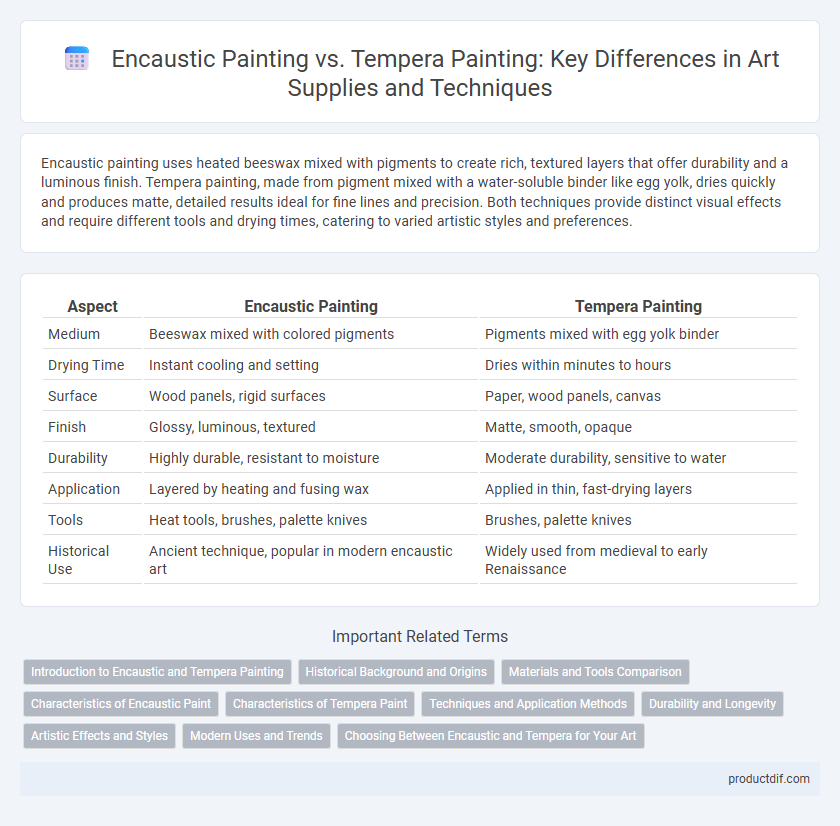Encaustic painting uses heated beeswax mixed with pigments to create rich, textured layers that offer durability and a luminous finish. Tempera painting, made from pigment mixed with a water-soluble binder like egg yolk, dries quickly and produces matte, detailed results ideal for fine lines and precision. Both techniques provide distinct visual effects and require different tools and drying times, catering to varied artistic styles and preferences.
Table of Comparison
| Aspect | Encaustic Painting | Tempera Painting |
|---|---|---|
| Medium | Beeswax mixed with colored pigments | Pigments mixed with egg yolk binder |
| Drying Time | Instant cooling and setting | Dries within minutes to hours |
| Surface | Wood panels, rigid surfaces | Paper, wood panels, canvas |
| Finish | Glossy, luminous, textured | Matte, smooth, opaque |
| Durability | Highly durable, resistant to moisture | Moderate durability, sensitive to water |
| Application | Layered by heating and fusing wax | Applied in thin, fast-drying layers |
| Tools | Heat tools, brushes, palette knives | Brushes, palette knives |
| Historical Use | Ancient technique, popular in modern encaustic art | Widely used from medieval to early Renaissance |
Introduction to Encaustic and Tempera Painting
Encaustic painting uses heated beeswax mixed with colored pigments, allowing artists to create textured, layered works that are both luminous and durable. Tempera painting involves mixing pigment with a water-soluble binder, typically egg yolk, producing fast-drying, matte finishes ideal for fine detail and vibrant color retention. Both techniques have ancient origins but differ significantly in medium characteristics, application methods, and visual effects.
Historical Background and Origins
Encaustic painting traces its origins to ancient Egypt and Greece, where artists used heated beeswax mixed with pigment to create durable, vibrant artworks, exemplified by the Fayum mummy portraits. Tempera painting, on the other hand, emerged in early Renaissance Europe, utilizing egg yolk as a binder to produce detailed and long-lasting images on wooden panels. Both techniques have historically influenced artistic developments, reflecting distinct cultural practices and material innovations in their respective periods.
Materials and Tools Comparison
Encaustic painting utilizes heated beeswax mixed with colored pigments applied with metal tools or brushes, while tempera painting relies on pigments mixed with a water-soluble binder, often egg yolk, and is typically applied with fine brushes on wood panels or paper. Encaustic materials require specialized equipment like heat sources and metal spatulas to manipulate the wax, whereas tempera demands precise mixing and quick application due to its fast-drying properties. Both techniques offer unique textures and finishes, with encaustic providing layered, glossy effects and tempera delivering matte, detailed results.
Characteristics of Encaustic Paint
Encaustic paint is composed of pigments mixed with hot beeswax, creating a rich, luminous texture that is both durable and flexible. It allows for layering and can be manipulated with heat to achieve unique effects such as translucency and texture variation. Unlike tempera paint, which dries quickly and has a matte finish, encaustic paint retains vibrant colors and a glossy surface over time.
Characteristics of Tempera Paint
Tempera paint is characterized by its quick-drying properties and a matte finish, created by mixing pigment with a water-soluble binder, typically egg yolk. This medium offers excellent color permanence and fine detail control, making it ideal for precise, layered artwork. Unlike encaustic paint, tempera lacks a waxy texture and requires a rigid support such as wood panels for stable application and longevity.
Techniques and Application Methods
Encaustic painting involves using heated beeswax mixed with colored pigments applied to a surface, allowing artists to layer, carve, and fuse the wax for textured, vibrant effects. Tempera painting utilizes egg yolk as a binder combined with pigment, resulting in a fast-drying, matte finish often applied with fine brushstrokes on rigid supports like wood panels. Encaustic requires specialized tools for heating and blending wax, while tempera relies on water-based techniques and precise layering to build luminosity and detail.
Durability and Longevity
Encaustic painting, utilizing heated beeswax mixed with pigments, offers exceptional durability as it resists moisture, cracking, and fading over centuries, preserving vivid colors and texture. Tempera painting, composed of pigment and egg yolk, is known for its longevity on rigid surfaces like wood panels but is more susceptible to cracking and deterioration if exposed to humidity and temperature fluctuations. Both mediums require proper care, but encaustic's wax base provides superior preservation qualities compared to tempera's more fragile, water-soluble binder.
Artistic Effects and Styles
Encaustic painting produces vibrant, textured surfaces with a luminous, waxy finish that enhances depth and dimensionality, making it ideal for rich, layered abstract and expressive artworks. Tempera painting offers a matte, smooth surface with precise, fine details and crisp lines, lending itself to detailed, illustrative styles and classical realism. Both mediums enable unique artistic expressions, with encaustic favoring tactile, dynamic effects and tempera emphasizing controlled, delicate brushwork.
Modern Uses and Trends
Encaustic painting, known for its vibrant, layered textures created by heated beeswax mixed with pigments, is increasingly popular in contemporary mixed-media art for its durability and unique tactile qualities. Tempera painting, traditionally made from pigment and egg yolk, remains favored in modern illustration and restoration work due to its fast-drying properties and matte finish. Artists today often blend encaustic techniques with digital elements or use tempera in eco-friendly art projects, reflecting trends toward sustainability and innovation in the art supply market.
Choosing Between Encaustic and Tempera for Your Art
Encaustic painting utilizes heated beeswax mixed with pigments, offering rich texture and a luminous finish that enhances depth and durability, ideal for artists seeking vibrant, layered effects. Tempera painting, made from pigment mixed with egg yolk and water, provides a fast-drying, matte surface with precise detail and long-lasting color stability, favored for fine line work and historical art techniques. When choosing between encaustic and tempera, consider factors like drying time, desired texture, color vibrancy, and the specific artistic style or preservation needs of the project.
Encaustic Painting vs Tempera Painting Infographic

 productdif.com
productdif.com